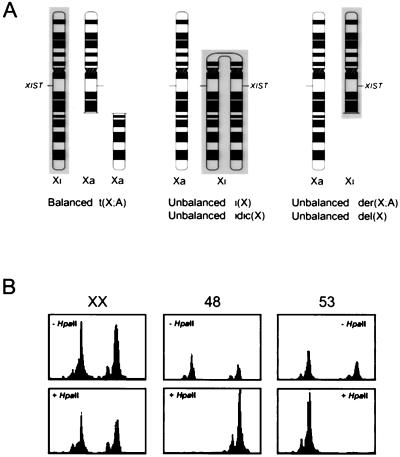Figure 1.
Nonrandom inactivation in females with structurally abnormal Xs. (A) Fibroblast cell lines were studied from individuals carrying balanced [t(X;A)] or unbalanced [der(X;A)] X; autosome translocations, iso- or isodicentric chromosomes [i(X), idic(X)], or deleted X chromosomes [del(X)]. X chromosomes (normal or with structural rearrangements) that contain the XIST gene can be inactivated (shaded). In carriers of balanced X;A translocations, inactivation of the normal X ensures proper dosage of X-linked gene products (41). In other cases, structurally abnormal Xs are inactivated in females, establishing proper dosage from the active normal X (42). (B) Methylation assay at the androgen receptor gene (AR) to establish nonrandom inactivation. An HpaII site is adjacent to the polymorphic trinucleotide repeat. Digestion of genomic DNA with HpaII prior to amplification digests the unmethylated allele on the Xa chromosome. Subsequent PCR amplifies only the methylated allele(s) on Xi chromosomes. The relative representation of each allele in the HpaII-digested samples (+HpaII), as compared with the amplified undigested samples (−HpaII), demonstrates the randomness (as seen in the sample from a normal XX female) or nonrandomness of X inactivation (cases 48 and 53).

